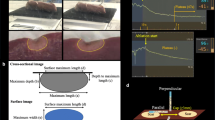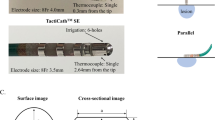Abstract
Purpose
The size of the distal electrode and the method of measuring local impedance (LI) are different between the IntellaNav MiFi-OI™ (MiFi-OI) and IntellaNav STABLE POINT™ (SP) catheters. We investigated the impact of these differences on LI, efficacy, and safety of radiofrequency (RF) applications.
Methods
RF applications at a range of powers (30 W, 40 W, and 50 W), contact forces (10 g and 20 g), and durations (10–120 s) were performed in excised porcine hearts (N = 48). LI variation was defined by δLI-drop (= initial LI − post-RF LI) and %LI-drop (= δLI-drop/initial LI) × 100, and the relationship between lesion characteristics and LI variation was compared.
Results
A total of 576 lesions were examined. Although absolute δLI-drop during RF applications was significantly larger for the SP than MiFi-OI catheter (47[31–65]ohm for SP vs 37[24–51]ohm for MiFi-OI, p < 0.0001), %LI-drop was similar (23.3 [15.5–30.6]% in SP vs 24.9[17.3–32.5]% in MiFi-OI, p = 0.10). Although lesions produced by both catheters were similarly correlated with LI variation, the SP catheter produced generally larger lesions (depth; 5.0 [3.7–6.1]mm vs 4.7 [3.3–6.0]mm, p = 0.06; surface areas, 46.9 [36.8–58.8]mm2 vs 44.7 [34.3–55.5]mm2, p = 0.02; volume, 321 [165–533]mm3 vs 265[141–471]mm3, p = 0.02). Steam pops were similarly observed with both catheters. In both catheters, %LI-drop was superior to δLI-drop in correlation to lesion size (p < 0.0001) and in predicting steam pops (p < 0.01).
Conclusions
Although no difference in safety profile is observed between MiFi-OI and SP catheters, the SP catheter produces larger lesions. %LI-drop is superior to δLI-drop in correlation to lesion size and in predicting steam pops as well as in normalizing the difference between catheters.





Similar content being viewed by others
References
El Haddad M, Taghji P, Phlips T, Wolf M, Demolder A, Choudhury R, et al. Determinants of acute and late pulmonary vein reconnection in contact force-guided pulmonary vein isolation: identifying the weakest link in the ablation chain. Circ Arrhythm Electrophysiol. 2017;10:e004867. https://doi.org/10.1161/CIRCEP.116.004867.
Ariyarathna N, Kumar S, Thomas SP, Stevenson WG, Michaud GF. Role of contact force sensing in catheter ablation of cardiac arrhythmias: evolution or history repeating itself? JACC Clin Electrophysiol. 2018;4:707–23. https://doi.org/10.1016/j.jacep.2018.03.014.
Petersen HH, Chen X, Pietersen A, Svendsen JH, Haunsø S. Tissue temperatures and lesion size during irrigated tip catheter radiofrequency ablation: an in vitro comparison of temperature-controlled irrigated tip ablation, power-controlled irrigated tip ablation, and standard temperature-controlled ablation. Pacing Clin Electrophysiol. 2000;23:8–17. https://doi.org/10.1111/j.1540-8159.2000.tb00644.x.
Thiagalingam A, D’Avila A, Foley L, Guerrero JL, Lambert H, Leo G, et al. Importance of catheter contact force during irrigated radiofrequency ablation: evaluation in a porcine ex vivo model using a force-sensing catheter. J Cardiovasc Electrophysiol. 2010;21:806–11. https://doi.org/10.1111/j.1540-8167.2009.01693.x.
Avitall B, Mughal K, Hare J, Helms R, Krum D. The effects of electrode-tissue contact on radiofrequency lesion generation. PACE - Pacing Clin Electrophysiol. 1997;20:2899–910. https://doi.org/10.1111/j.1540-8159.1997.tb05458.x.
Harvey M, Kim Y-N, Sousa J, el-Atassi R, Morady F, Calkins H, et al. Impedance monitoring during radiofrequency catheter ablation in humans. Pacing Clin Electrophysiol. 1992;15:22–7. https://doi.org/10.1111/j.1540-8159.1992.tb02897.x.
Sulkin MS, Laughner JI, Hilbert S, Kapa S, Kosiuk J, Younan P, et al. Novel measure of local impedance predicts catheter-tissue contact and lesion formation. Circ Arrhythm Electrophysiol. 2018;11(4):e005831. https://doi.org/10.1161/CIRCEP.117.005831.
Garrott K, Laughner J, Gutbrod S, Sugrue A, Shuros A, Sulkin M, et al. Combined local impedance and contact force for radiofrequency ablation assessment. Heart Rhythm. 2020;17:1371–80.
Martin CA, Martin R, Gajendragadkar PR, Maury P, Takigawa M, Cheniti G, et al. First clinical use of novel ablation catheter incorporating local impedance data. J Cardiovasc Electrophysiol. 2018;29:1197–206.
Iwakawa H, Takigawa M, Goya M, Iwata T, Martin CA, Anzai T, et al. Clinical implications of local impedance measurement using the IntellaNav MiFi OI ablation catheter: an ex vivo study. J Interv Card Electrophysiol. 2022;63:185–95. https://doi.org/10.1007/s10840-021-00954-8.
El Haddad M, Taghji P, Phlips T, Wolf M, Demolder A, Choudhury R, et al. A novel assessment of local impedance during catheter ablation: initial experience in humans comparing local and generator measurements. Europace. 2019;21:i34–42. https://doi.org/10.1093/europace/euy273.
Takigawa M, Goya M, Iwakawa H, Martin CA, Anzai T, Takahashi K, et al. Impact of a formula combining local impedance and conventional parameters on lesion size prediction. J Interv Card Electrophysiol. 2022;(63):389–98. https://doi.org/10.1007/s10840-021-01013-y.
Sheskin DJ. Handbook of parametric and nonparametric statistical procedures. 5th ed. Boca Raton: Chapman and Hall/CRC; 2011.
Das M, Luik A, Shepherd E, Sulkin M, Laughner J, Oesterlein T, et al. Local catheter impedance drop during pulmonary vein isolation predicts acute conduction block in patients with paroxysmal atrial fibrillation: initial results of the LOCALIZE clinical trial. Europace. 2021;23:1042–51.
Solimene F, Giannotti Santoro M, De Simone A, Malacrida M, Stabile G, et al. Pulmonary vein isolation in atrial fibrillation patients guided by a novel local impedance algorithm: 1-year outcome from the CHARISMA study. J Cardiovasc Electrophysiol. 2021;32:1540–8.
Szegedi N, Salló Z, Perge P, Piros K, Nagy VK, Osztheimer I, et al. The role of local impedance drop in the acute lesion efficacy during pulmonary vein isolation performed with a new contact force sensing catheter-a pilot study. PLoS ONE. 2021;16(9):e0257050. https://doi.org/10.1371/journal.pone.0257050.
Guerra JM, Jorge E, Raga S, Gálvez-Montón C, Alonso-Martín C, Rodríguez-Font E, et al. Effects of open-irrigated radiofrequency ablation catheter design on lesion formation and complications: in vitro comparison of 6 different devices. J Cardiovasc Electrophysiol. 2013;24:1157–62.
Yokoyama K, Nakagawa H, Shah DC, Lambert H, Leo G, Aeby N, et al. Novel contact force sensor incorporated in irrigated radiofrequency ablation catheter predicts lesion size and incidence of steam pop and thrombus. Circ Arrhythm Electrophysiol. 2008;1:354–62.
Winterfield JR, Jensen J, Gilbert T, Marchlinski F, Natale A, Packer D, et al. Lesion size and safety comparison between the novel flex tip on the FlexAbility ablation catheter and the solid tips on the ThermoCool and ThermoCool SF ablation catheters. J Cardiovasc Electrophysiol. 2016;27:102–9.
Ikeda A, Nakagawa H, Lambert H, Shah DC, Fonck E, Yulzari A, et al. Relationship between catheter contact force and radiofrequency lesion size and incidence of steam pop in the beating canine heart: electrogram amplitude, impedance, and electrode temperature are poor predictors of electrode-tissue contact force and lesion. Circ Arrhythm Electrophysiol. 2014;7:1174–80.
Seiler J, Roberts-Thomson KC, Raymond JM, Vest J, Delacretaz E, Stevenson WG. Steam pops during irrigated radiofrequency ablation: feasibility of impedance monitoring for prevention. Heart Rhythm. 2008;5:1411–6.
Mansour M, Calkins H, Osorio J, Pollak SJ, Melby D, Marchlinski FE, et al. Persistent atrial fibrillation ablation with contact force-sensing catheter: the prospective multicenter PRECEPT trial. JACC Clin Electrophysiol. 2020;6:958–69.
Gonna H, Domenichini G, Zuberi Z, Norman M, Kaba R, Grimster A, et al. Initial clinical results with the ThermoCool SmartTouch Surround Flow catheter. Europace. 2017;19:1317–21.
Pezzulich B, Taralli S, Villata G, Sori P. Clinical experience with a novel, irrigated, flexible tip ablation catheter in atrial fibrillation ablation. Minerva Cardioangiol. 2015;63:99–103.
Acknowledgements
We are grateful to Mr. Tomohiro Nagao, an employee of Boston Scientific Japan, for a technical support of this experiment.
Author information
Authors and Affiliations
Corresponding author
Ethics declarations
Ethics approval
The ethical committee of Tokyo Medical and Dental University granted an exemption from requiring ethics approval because this research was neither a clinical study nor an animal experiment.
Conflict of interest
Dr. Martin and Dr. Miyazaki have received consulting fees from Boston Scientific. Dr. Takigawa and Miyazaki received endowments from Medtronic Japan, Boston Scientific, Japan Lifeline, and WIN international. All other authors declare no competing interests.
Additional information
Publisher’s note
Springer Nature remains neutral with regard to jurisdictional claims in published maps and institutional affiliations.
Supplementary Information
Below is the link to the electronic supplementary material.
Rights and permissions
About this article
Cite this article
Amemiya, M., Takigawa, M., Goya, M. et al. Comparison of two catheters measuring local impedance: local impedance variation vs lesion characteristics and steam pops. J Interv Card Electrophysiol 65, 419–428 (2022). https://doi.org/10.1007/s10840-022-01214-z
Received:
Accepted:
Published:
Issue Date:
DOI: https://doi.org/10.1007/s10840-022-01214-z




